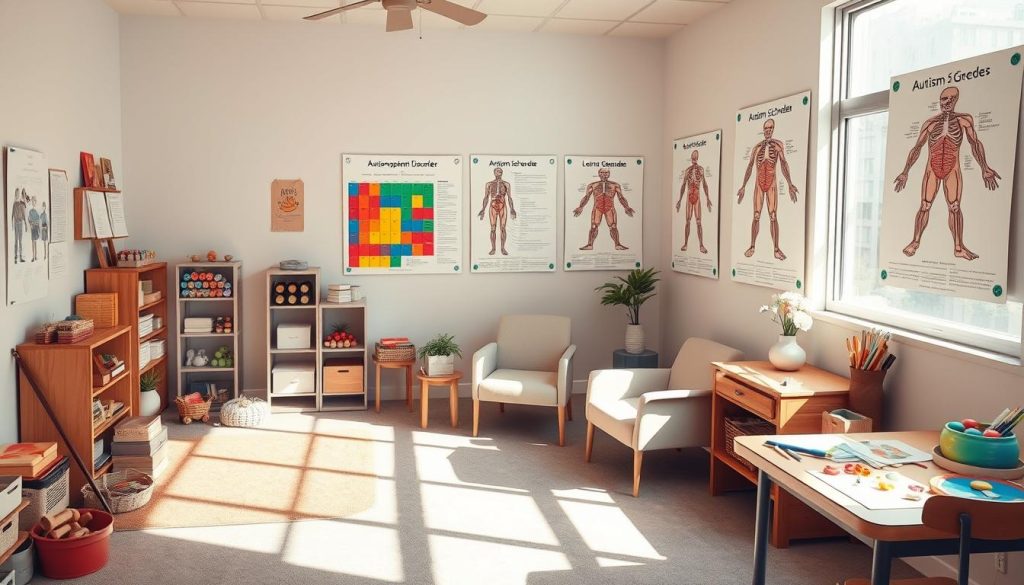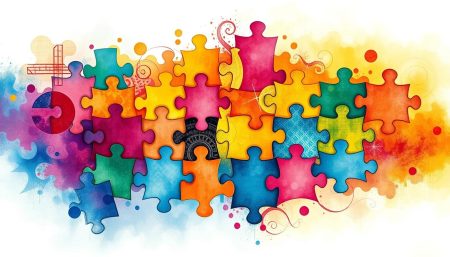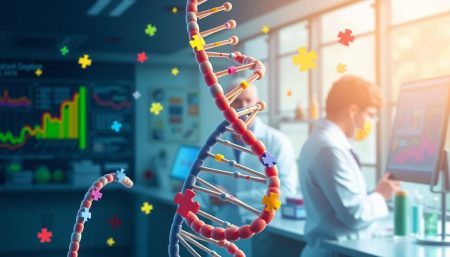Exploring Autism Spectrum Disorder (ASD) opens a world where different behaviors and ways of communicating are normal. It’s time to clear up what autism spectrum disorder is. This journey helps us understand and connect with others better.
The autism definition is complex. It includes many differences in thinking, social skills, and feelings. These differences affect how people communicate and interact. We learn about ASD from places like the Centers for Disease Control and Prevention and Autism Speaks.
Understanding autism spectrum disorder helps us see its unique aspects. Each person with ASD has their own strengths and challenges. We aim to break down stereotypes and offer a detailed look at ASD, based on real-life experiences.
This guide will take you through the medical, social, and personal sides of autism. We want to share more than just facts. We want to tell stories that show the deep humanity in autism spectrum disorder.
Understanding Autism Spectrum Disorder
Autism Spectrum Disorder (ASD) is a complex neurodevelopmental condition. It shows different autism symptoms in each person. This makes it hard to fully understand and treat.
ASD has many causes of autism spectrum disorder. These include genetic mutations and environmental factors. Studies show that both genetics and environment play a role in ASD. This mix makes diagnosing and understanding ASD even more complex.
- Behavioral and cognitive differences
- Challenges in social interactions
- Communication difficulties
- Sensory sensitivities
When talking about autism symptoms, it’s important to note their wide range. Symptoms include social communication issues, repetitive behaviors, and sensory sensitivities. These symptoms often start in early childhood and can affect daily life.
| Aspect | Manifestation in ASD |
|---|---|
| Communication | Limited use of gestures; delays in speaking; difficulty understanding abstract language |
| Social Interaction | Struggles with conventional social rules; reduced interest in social interactions |
| Behavioral | Repetitive actions; high preference for routines; intense focus on specific interests |
| Sensory Input | Over- or under-sensitivity to sounds, lights, touch, and smells |
In summary, fully grasping understanding autism spectrum disorder requires acknowledging its complex symptoms and varied causes. It also means tailoring support and intervention to meet each person’s unique needs.
Exploring the Complexity of Autism Symptoms
Autism Spectrum Disorder (ASD) has many symptoms that show up differently in each person. We’ll look at three main areas: behavioral signs, communication challenges, and social interaction difficulties. These are key signs of autism. Knowing about them helps us support those with ASD better.
Behavioral Signs of Autism
Behavioral signs of autism are often the first clue that leads to an ASD evaluation. These signs can include repetitive actions, intense interests, and strict routines. How these signs show up can greatly impact daily life and social interactions.
- Repetitive movements such as rocking or hand-flapping
- Persistent fixation on specific topics or objects
- Insistence on following routines with little tolerance for changes
Communication Challenges and Autism
Communication problems are big autism symptoms that affect talking and non-verbal interactions. Some people might not speak at all, while others might have a big vocabulary but struggle with communication skills like tone and body language.
- Delayed speech development or absence of babbling in toddlers
- Challenges in using and understanding gestures or facial expressions
- Difficulty in adjusting communication style to different social contexts
Social Interaction Difficulties in Autism
Social interactions are hard for people with ASD. Symptoms include seeming not to care about others, not getting social cues, and having trouble keeping friends. It’s important to understand these challenges to create supportive social spaces.
- Difficulty in making eye contact and preferring solitude
- Misinterpretation of social cues leading to unintended social blunders
- Challenges in sharing interests or achievements with peers
Causes of Autism Spectrum Disorder
Understanding the causes of autism spectrum disorder (ASD) is key for early diagnosis and help. The debate on these causes has always mixed genetics and environment. Recent studies highlight the role of early brain growth in this mix.
Genetics play a big part in ASD. Studies in Nature Genetics show that genetic problems can lead to autism. These problems can be passed down or happen for the first time in a family.
Environmental factors also matter, as Current Opinion in Pediatrics suggests. Things like chemicals, viruses, and pregnancy issues can increase autism risk.
Early brain issues are also important, as The Lancet points out. Problems in brain growth early on can affect behavior and skills later. These are often seen in autism.
- Genetic predispositions
- Environmental influences
- Abnormalities in brain development
To show how these causes work together, see the table below. It shows how genetics and environment interact:
| Genetic Factors | Environmental Influences | Early Brain Development |
|---|---|---|
| Hereditary genetic mutations | Prenatal exposure to pollutants | Neural connectivity disruptions |
| De novo mutations | Maternal health issues during pregnancy | Altered brain growth rates |
Research shows ASD is a complex mix of factors. Knowing these helps in diagnosing and supporting those with autism and their families.
How Autism Spectrum Disorder is Diagnosed
Diagnosing autism in children is a detailed process. It includes watching for developmental milestones, doing medical and psychological tests, and looking at the family history. This careful method helps make sure the diagnosis is right. It also guides the support and help needed.
Evaluating Developmental Milestones
Watching a child’s development from birth is key. Doctors check if they hit important milestones like talking, moving, and social skills on time. If they don’t, it might mean they need more tests.
Medical and Psychological Assessments
After noticing something different, more tests are done. These include tests for hearing and senses, thinking skills, and behavior. Each test helps figure out if it’s autism or something else.
The Role of Family History in Diagnosis
Knowing the family’s health history is also important. Doctors ask about relatives with autism to understand the child’s chances of having it. This helps them understand the child’s condition better.

| Assessment Type | Focus Area | Purpose |
|---|---|---|
| Developmental Screening | Early childhood development | Identify early signs of developmental delays |
| Cognitive Assessment | Intellectual abilities | Evaluate learning capabilities and challenges |
| Behavioral Evaluation | Social and communication skills | Assess social interactions and behavioral responses |
| Family Medical History | Genetic predisposition | Analyze genetic links to autism |
The Autism Definition and Its Importance
Understanding autism spectrum disorder starts with a clear autism definition. The World Health Organization and the International Classification of Diseases define it. It includes challenges with social skills, repetitive behaviors, and communication. People with ASD also have unique strengths and differences.
An accurate autism definition is key for diagnosis and awareness. It helps healthcare professionals, educators, and families support those with ASD. It also leads to more acceptance and better access to resources.
- Detailed Diagnosis: A clear autism definition helps in identifying the condition early, which is critical for effective intervention.
- Research and Development: Understanding autism spectrum disorder drives research for new treatments and the causes of ASD.
- Community Awareness: Teaching the public about autism reduces stigma and promotes inclusion.
In summary, the autism definition shapes how we diagnose and care for ASD. It also affects how society views and supports those with ASD. A precise definition and widespread understanding can lead to better treatments and a more inclusive society.
Autism Spectrum Disorder in Children
It’s important to understand autism spectrum disorder in kids for early help. This condition makes social interactions, behaviors, and communication hard. Spotting the signs early can really help a child grow and live better.
Autism spectrum disorder in children shows in different ways. Kids might not make eye contact, repeat actions, or find it hard to adjust to new places. Finding these signs early is key to start the right treatments.
- Limited or inconsistent eye contact
- Delayed speech and communication skills
- Unusual repetitive behaviors such as flapping, rocking, or spinning
- Intense interest in specific topics
- Heightened or reduced sensitivity to sensory inputs like sound or touch
Finding autism early is very important. Studies show early help can really make a difference. It can help kids talk better, make friends, and behave in a more normal way.
| Age | Common Signs | Intervention Strategies |
|---|---|---|
| 2-3 Years | Minimal verbal communication, poor social interaction. | Speech therapy, behavior therapy. |
| 4-5 Years | Repetitive behaviors, challenges in play with peers. | Occupational therapy, structured learning environments. |
| 6-8 Years | Difficulty understanding social rules, challenges in adapting to school. | Social skills groups, educational support. |
If you think your child might have autism, talk to a doctor. Pediatricians, child psychologists, and therapists can help a lot. Early and right help can help kids do their best.
Support and Treatment Options for Autism
Looking into effective autism treatments is key to improving life for those with Autism Spectrum Disorder (ASD). Methods like behavior and communication therapies, along with educational plans and family support, have proven to be very helpful.
Behavior and Communication Therapies
Behavior and communication therapies are core parts of autism treatment. They help improve communication and social skills, which are often tough for those with ASD. Techniques like Applied Behavior Analysis (ABA) and speech therapy are known to be effective. They help develop important life skills and boost communication abilities.
Educational Therapies and Autism
Educational therapies offer structured learning environments. They use customized educational plans to help kids with ASD. These plans focus on the strengths of each child while supporting areas of challenge. This ensures a well-rounded education that meets each student’s unique needs.
Family Counseling and Support Groups
Family counseling and support groups are essential for families with ASD. They offer the support needed to manage daily life. These resources help families through shared experiences, guidance, and creating a supportive environment. This environment helps in nurturing the developmental path of their loved one with autism.
Early Signs of Autism Spectrum Disorder
Spotting the early signs of autism spectrum disorder is key for a quick diagnosis. This early catch can lead to interventions that greatly help a child’s growth. Here are some important signs parents and caregivers should watch for.
- Delayed speech development: Not hitting language milestones can be a clue.
- Minimal eye contact: Babies and young kids with autism often shy away from eye contact.
- Limited pointing or gestures: By 12 to 14 months, gestures should start, but autism might delay this.
- Unusual play with toys: Not using toys as they’re meant to be used or being too focused on parts of objects.
- Repetitive behaviors: Doing the same actions over and over, like rocking, spinning, or hand-flapping.
Spotting these signs is the first step towards an autism diagnosis. They’re not a final say but a hint to get an expert’s opinion. It’s all about watching over time and knowing when to seek help.
| Sign | Typical Age of Onset | Common Observations |
|---|---|---|
| Speech delays | 2 years | Less verbal than peers, limited babbling or vocalization. |
| Minimal eye contact | 6 months | Infrequent looking at faces and social stimuli. |
| Repetitive behaviors | 1 year | Repeating actions extensively and insistence on sameness. |

What is Autism Spectrum Disorder: Unveiling the Myths
When we talk about what is autism spectrum disorder, it’s key to clear up common myths. These myths can make it hard to understand autism spectrum disorder. They affect how people see autism and those who live with it.
Many think all people with autism face the same issues. But, autism is a spectrum, so each person’s experience is different. Let’s look at some myths and share facts backed by recent studies.
| Myth | Fact | Source |
|---|---|---|
| Autism is just a childhood disorder | Autism is a lifelong condition that affects individuals differently at different stages of life. | Journal of Autism and Developmental Disorders |
| People with autism are not social | Many individuals with autism want to connect but may do it in their own way. | Focus on Autism and Other Developmental Disabilities |
| Autism can be cured | There’s no cure for autism, but therapies can help manage symptoms and improve life quality. | Autism Research |
To better understand autism spectrum disorder, we must tackle these myths. Accepting diversity and sharing correct info helps create a more welcoming world. By learning and teaching others, we can better support those with autism and value the unique aspects of what is autism spectrum disorder.
Navigating Life with Autism: A Parent’s Perspective
Raising a child with autism is both challenging and rewarding. It’s important to understand the support needed on this journey. Family counseling and support groups play a big role in this.
Creating a Supportive Home Environment
A supportive home is key for a child with autism. Parents use routines, sensory-friendly spaces, and compassion to meet their child’s needs. Making home adjustments, like quieter areas and calming colors, helps too.
Accessing Community Resources and Support
Finding the right community resources is vital for a child’s well-being. Support groups offer a network of understanding peers. Family counseling helps manage the effects of autism on family life.
- Family Support Groups: These groups provide emotional support and practical advice, helping to feel less alone.
- Educational Workshops: Community centers often host sessions on autism, helping the whole family understand and manage it better.
- Therapeutic Services: Access to autism specialists can have a big positive impact.
| Resource | Description | Benefits |
|---|---|---|
| Local Autism Support Groups | Meetings for sharing experiences and strategies | Emotional and social support, updated information |
| Special Needs Education Programs | Programs tailored to children with ASD | Customized learning approaches, social integration |
| Family Counseling Centers | Professional guidance for family members | Improved family communication, reduced stress |
Addressing the Needs of Adults with Autism Spectrum Disorder
As society learns more about understanding autism spectrum disorder, it’s key to meet the needs of adults with it. This means looking at jobs, social connections, and being independent.
There’s a big talk about autism spectrum disorder in adults and jobs. Many adults with autism have special skills but face job hurdles. This is because of how jobs are set up and the work places they’re in.
- Improving how jobs are filled to use the skills of people with autism.
- Changing work places to help with differences in how people sense things and talk.
Getting along socially is hard for adults with autism. They might find it tough to keep friends and join groups that interest them.
- Creating special groups for social skills and making friends.
- Planning events that autistic adults will enjoy, making them feel included.
Helping adults with autism be independent is very important. Being able to take care of themselves, handle money, and make choices can make their lives better.
| Area of Independence | Support Strategies |
|---|---|
| Daily Living Skills | Customized life skills coaching and practical supports |
| Financial Management | Financial literacy workshops tailored to individual learning styles |
| Decision Making | Programs to enhance self-advocacy and informed decision-making |
Learning about understanding autism spectrum disorder in adults helps them and the community. It brings in new talents and views that were missed before.
Advancements in Autism Research and Future Perspectives
The field of advancements in autism research has grown a lot in recent years. This growth has helped us understand autism spectrum disorder better. Researchers have found new genetic markers and brain patterns linked to autism. This gives us deeper insights and helps us diagnose autism more accurately.
Technology is also playing a big role in autism research and treatment. It includes AI for analyzing genetic data and augmented reality for social skills training. These technologies are changing how we see and treat autism.
This research progress is not just expanding our knowledge. It’s also improving the lives of people with autism. Every new study helps us offer better support and treatments.
| Year | Innovation in Autism Research | Impact on Treatment |
|---|---|---|
| 2021 | Identification of new genetic markers | Enhanced personalization of therapeutic strategies |
| 2022 | Development of AI tools for behavioral analysis | Improved accuracy in behavioral assessment |
| 2023 | Introduction of augmented reality training tools | Increased efficacy in social skills development |
The work to find new ways and use new technologies shows a strong path for advancements in autism research. Looking ahead, teamwork from experts worldwide will likely lead to more big discoveries. These could change how we care for and help people with autism a lot.
Integrating Technology in Autism Treatment and Care
The world of autism treatment options is always changing. Integrating technology is key in creating new therapies. New tech has made care better, improving life for those with autism spectrum disorder (ASD).
Digital tools for autism care include communication aids and educational apps. These tools help overcome challenges faced by those with autism. They make communication, learning, and interacting with the world easier.
- Assistive communication devices help enhance speech production and understanding.
- Virtual reality systems simulate real-world scenarios to teach coping strategies in a controlled setting.
- Interactive learning apps make educational content accessible and engaging through gamification.
A study in the Journal of Autism and Developmental Disorders shows apps can boost learning in kids with ASD. Another study in Computers in Human Behavior highlights virtual environments for social skills development.
| Technology Type | Use Case in Autism | Benefits |
|---|---|---|
| Virtual Reality | Social skills development | Safe, controlled exposure to social scenarios |
| Assistive Communication Devices | Communication enhancement | Facilitates expressive and receptive communication |
| Interactive Educational Apps | Learning and engagement | Customizable learning paths, immediate feedback |
By focusing on integrating technology in autism treatment options, we see new ways to help. This innovation goes beyond traditional therapies, opening doors to new interventions.
Autism and Education: Adapting Learning Environments
Schools in the United States are working hard to make education more inclusive for students with autism. They are learning from studies in the Journal of Research in Special Educational Needs and the International Journal of Inclusive Education. These studies show that changing educational spaces is key to better teaching students with Autism Spectrum Disorder (ASD).
Teachers are teaming up with experts to create better learning environments. This teamwork has led to spaces that are less distracting and meet students’ sensory needs. It also includes using technology to help students learn in ways that work best for them.
Changing learning environments for autism requires ongoing effort and flexibility. Teachers must keep up with their students’ changing needs and adjust their teaching methods. By doing this, schools can create a supportive learning environment for all students with ASD. This shows that inclusive education is growing and becoming more important.
FAQ
Q: What is Autism Spectrum Disorder?
A: Autism Spectrum Disorder (ASD) is a complex condition that affects how people see the world and interact. It impacts social skills, communication, behavior, and learning in different ways. Each person with ASD experiences it differently.
Q: What causes Autism Spectrum Disorder?
A: The exact causes of ASD are not known. But research points to a mix of genetic and environmental factors. Genes and complications during pregnancy or toxins may play a role.
Q: What are the signs of Autism Spectrum Disorder in children?
A: Signs in children include trouble with social interactions and communication. They might have repetitive behaviors and stick to routines. Early help is key for their development.
Q: How is Autism Spectrum Disorder diagnosed?
A: A team of specialists diagnoses ASD. They observe the child’s behavior and review their history. Assessments cover social, communicative, and cognitive skills.
Q: What treatment options are available for Autism Spectrum Disorder?
A: Treatments vary based on individual needs. They include behavioral and communication therapies, educational support, and family help. Medication may also be used for certain symptoms.
Q: Can adults have Autism Spectrum Disorder?
A: Yes, adults can have ASD. Some get diagnosed later in life. Adults face unique challenges and need tailored support.
Q: How does technology assist in autism therapy and care?
A: Technology helps in many ways. It includes apps, social stories, and virtual reality. These tools improve communication, social skills, and learning.
Q: What role does education play in the lives of individuals with Autism Spectrum Disorder?
A: Education is vital for those with ASD. It provides a structured learning environment. Specialized teaching and inclusive practices support their growth.
Q: What are some of the advancements in autism research?
A: Research has made great strides. New genetic markers and early detection methods have been found. Personalized treatments and neurobiology studies are ongoing.
Q: What are some ways parents can support a child with Autism Spectrum Disorder?
A: Parents can create a supportive home environment. They should access therapy and support groups. Staying informed about ASD and treatments is also important.


















